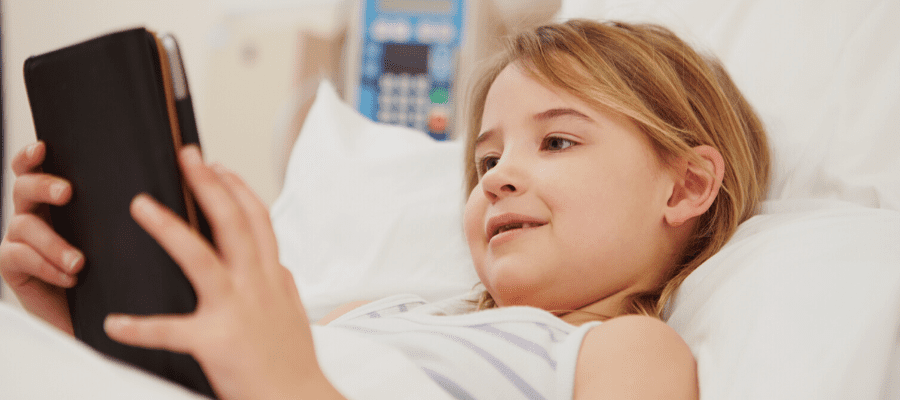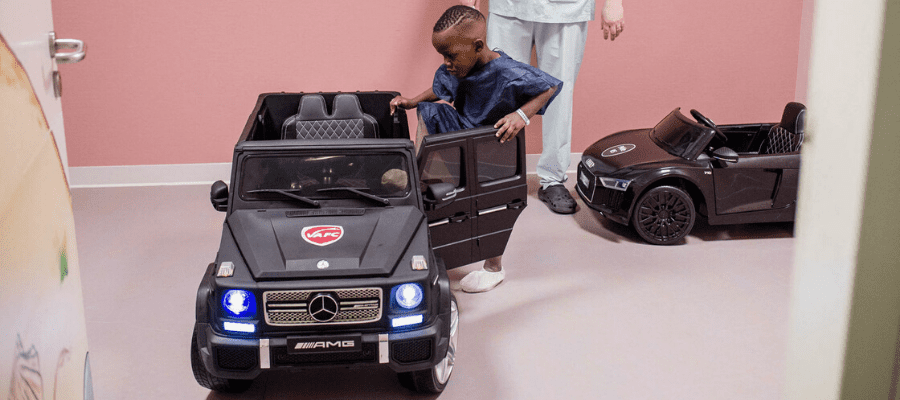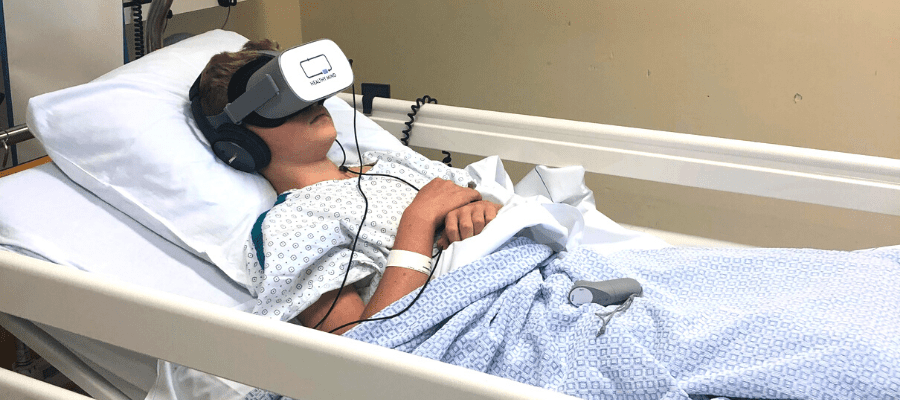Anxiety, discomfort, disorientation, feelings of powerlessness… The child hospitalization is stressful for the young patient, as well as for his parents. An anxiety that should not be taken lightly, since it can lead to an increase in analgesic doses, postoperative pain, behavioural problems. Therefore, how can we reduce children’s anxiety in hospital, especially before an operation? Here are a few solutions that have already been successful in many health care institutions.
1. Therapeutic play to reduce children’s anxiety in hospital
Therapeutic play aims to explain surgical care to the child in a playful and educational way, with toys and dolls. This role-playing game can be carried out on the initiative of parents or care staff, at home or at the hospital. Some hospitals, for example, organize this medical game during the pre-operative visit.
This therapeutic game will be effective if:
- You explain the situation and the medical acts in understandable terms.
- You use medical equipment that is as close to reality as possible, so that the child can become familiar with it.
Through this game, the child expresses his fears and asks his questions. In this way, he can prepare himself psychologically for the intervention, while better understanding its necessity.
For a few years now, French medical schools have been setting up days dedicated to the Teddy Bear Hospital. The purpose of these days? To familiarize children with the world of Health! Each of them is invited to come and take care of their teddy bear. Once there, the child goes through the different hospital services (stands run by the students), and meets the health professionals embodied by the students (nurses, anesthesiologists, pharmacists, surgeons…). Through the care, operations and medication given to the teddy bears, the students explain the different stages of the child care journey.
2. Applications on tablets
Some health care institutions provide shelves for hospitalized children. From these tablets, the young patient can watch explanatory videos on his or her care journey, or answer quizzes… A fun, entertaining and interactive way to transmit information, while involving the hospitalized child in his or her care journey.
For exemple, the Rennes University Hospital has developed a tablet application entitled “You are the hero!”. Via this application, the young boy or girl can create an avatar and go through the stages of his or her medical journey, just as he or she would validate levels in a video game. This application also allows the healthcare team to more easily take the blood pressure of a child, busy blowing up a virtual balloon on his or her tablet.

3. Customization of the hospital environment
Some hospital groups have chosen to decorate and customize their interior spaces:
- Decoration of ceilings and walls: some rooms are sometimes decorated with the patterns and colors of specific universes (pirate ship, fairy world, treasure island…).
- Customization of medical equipment, such as colorful prostheses in the colors of super heroes.
- Disguise of the nursing staff and children.
At the Saint-Laurent Polyclinic in Rennes, the MRI department has been completely relooked: the walls are covered with stars and rockets, and the MRIs are transformed into real “space travel”. As for the caregivers – disguised as cosmonauts – they offer children the opportunity to dress up as superheroes or princesses in their turn. Finally, they invite them aboard the rocket while preparing them “for take-off”. This interaction allows in particular :
- a better cooperation between the medical team and the child;
- to divert the child’s attention;
- to play down the situation.
4. Carts to take the patient to the operating room
One of the most anxiety-provoking moments of a child’s hospitalization is undoubtedly the separation from his or her parents, before being taken to the operating room. Therefore, why not take a child to the operating room in an electric cart, rather than on a stretcher? This is the choice that many French hospitals have already made. Arriving near the operating room, the young patient can choose the car of his choice among several colorful models: pink convertible, red Ferrari, motorcycle… After having installed the child inside, the caregiver teleguides or pushes the cart to the operating room.
These carts have a double advantage: they entertain the child, while facilitating the separation with the accompanying parents.

5. Visiting clowns, magicians and other professional artists
The clowns in charge of entertaining hospitalized children have been a real success for many years. According to the results of a study by the British Medical Journal, the presence of clowns could reduce anxiety, pain, tiredness and stress of children in hospital (Lopes-Junior, 2020). It would be beneficial for the psychological and emotional well-being of the child and parents through entertainment, or imaginary stimulation.
This is why many clowns, magicians and sandmen visit hospitalized children to provide magic tricks, stories, tales, songs, jokes, antics… This is notably the case of associations such as “Le Rire Médecin” or “Les Clowns de l’Espoir”.
Behind these clowns are in fact professional or amateur artists (actors, storytellers, puppeteers, magicians…), all of whom are doubly trained in an artistic activity and hospital intervention.
6. Relaxation and hypnosis through virtual reality
To relax an hospitalized child, medical hypnosis trough virtual reality is also a successfull solution. By offering therapeutic virtual reality headsets, Healthy Mind Group is able to relax a young patient at all stages of hospitalization, i.e. before, during or after an operation.
The use of these tools is very simple. All the hospitalized child has to do is place the headset on his face to be able to enjoy a 3D immersion. He is then immersed in enchanting worlds (Zen garden, diving, forest…), with relaxing visual and sound settings. A verbal accompaniment, based on the principles of medical hypnosis, invites him to breathe and relax.
Thus, Heathy Mind virtual reality helmets are used in several pediatric wards to relax children, namely :
- pediatric resuscitation;
- infusions and bandaging or plastering;
- palliative care;
- surgery;
- perioperative management of the child.
The relaxing benefits of Healthy Mind virtual headsets have been proven in the field of idiopathic scoliosis surgery (Assaker, 2020):
- 40% reduction in pre-operative anxiety;
- 80% decrease in morphine consumption.
They have also been proven in the perioperative management of children. Indeed, the use of Healthy Mind headsets has allowed an anxiety reduction for young patient and parents (Marsac, 2019) :
- 57% decrease in the child’s preoperative anxiety;
- 57% decrease in the anxiety of the accompanying parent.

In short, hospital techniques to relax a child have many benefits: entertainment, psychological preparation for the medical act, better understanding of the care course… They also reduce the need to take pre-operative medication and relax the accompanying parent, who will then be able to reassure the hospitalized child. Among the techniques presented in this article, virtual reality medical hypnosis is also used to relax hospitalized adults. Thus, virtual reality headsets for patients are already used in some french hospitals.
Source: :
- Lopes-Junior. L-C et al. (2020). Effectiveness of hospital clowns for symptom management in paediatrics: systematic review of randomised and non-randomised controlled trials. British Medical Journal, 371(4290), pp. 1-10.
- Assaker, R. et al. (2020, september). Effectiveness of VR in reducing anxiety and pain in pediatric idiopathic scoliosis surgery [Poster session]. 62nd Congress of the French Society of Anesthesia and Intensive Care, France.
- Marsac, L. et al. (2019, september). Evaluation of a virtual reality headset in prevention of peri operative anxiety in children [Poster session]. 61st Congress of the French Society of Anesthesia and Intensive Care, Paris, France.







